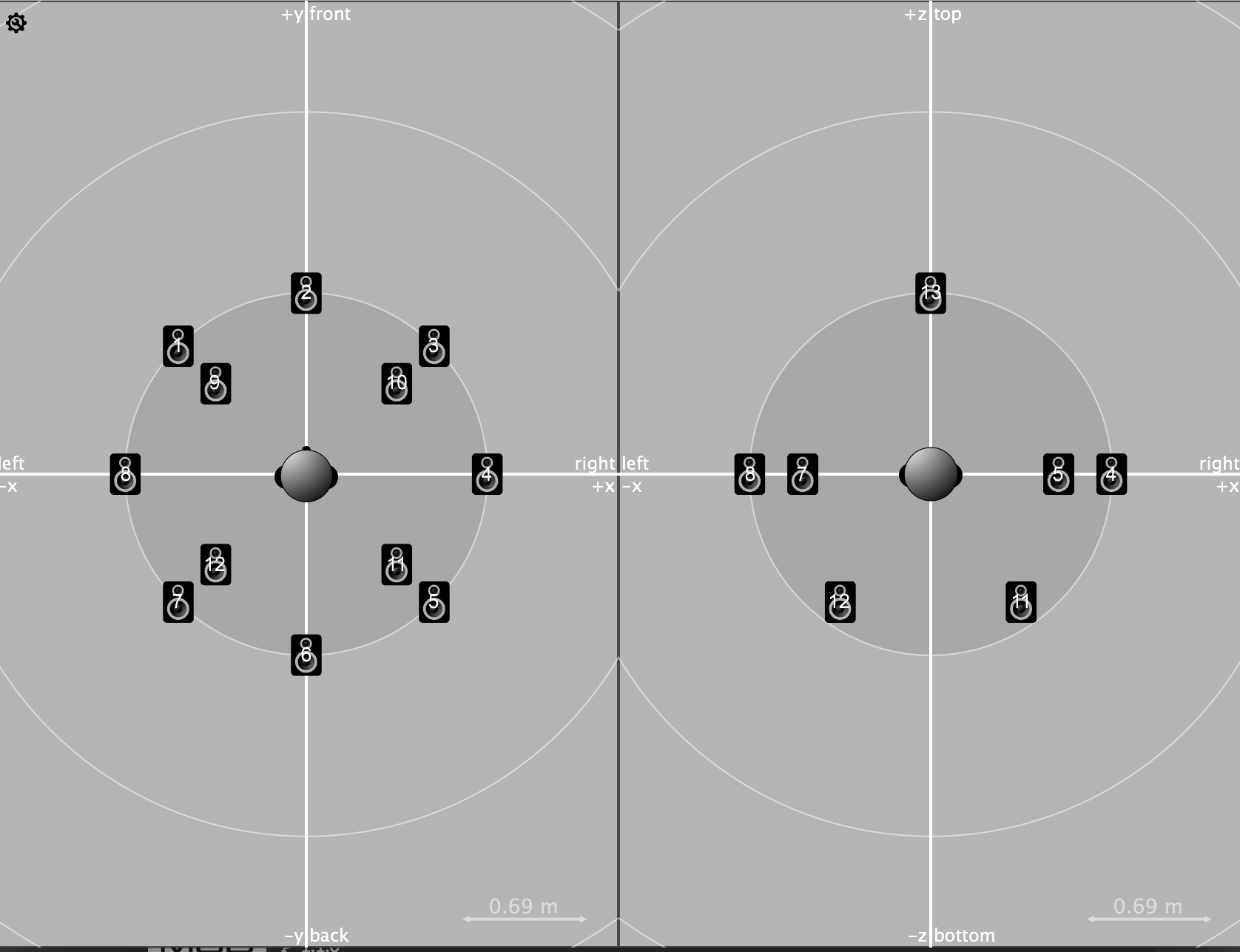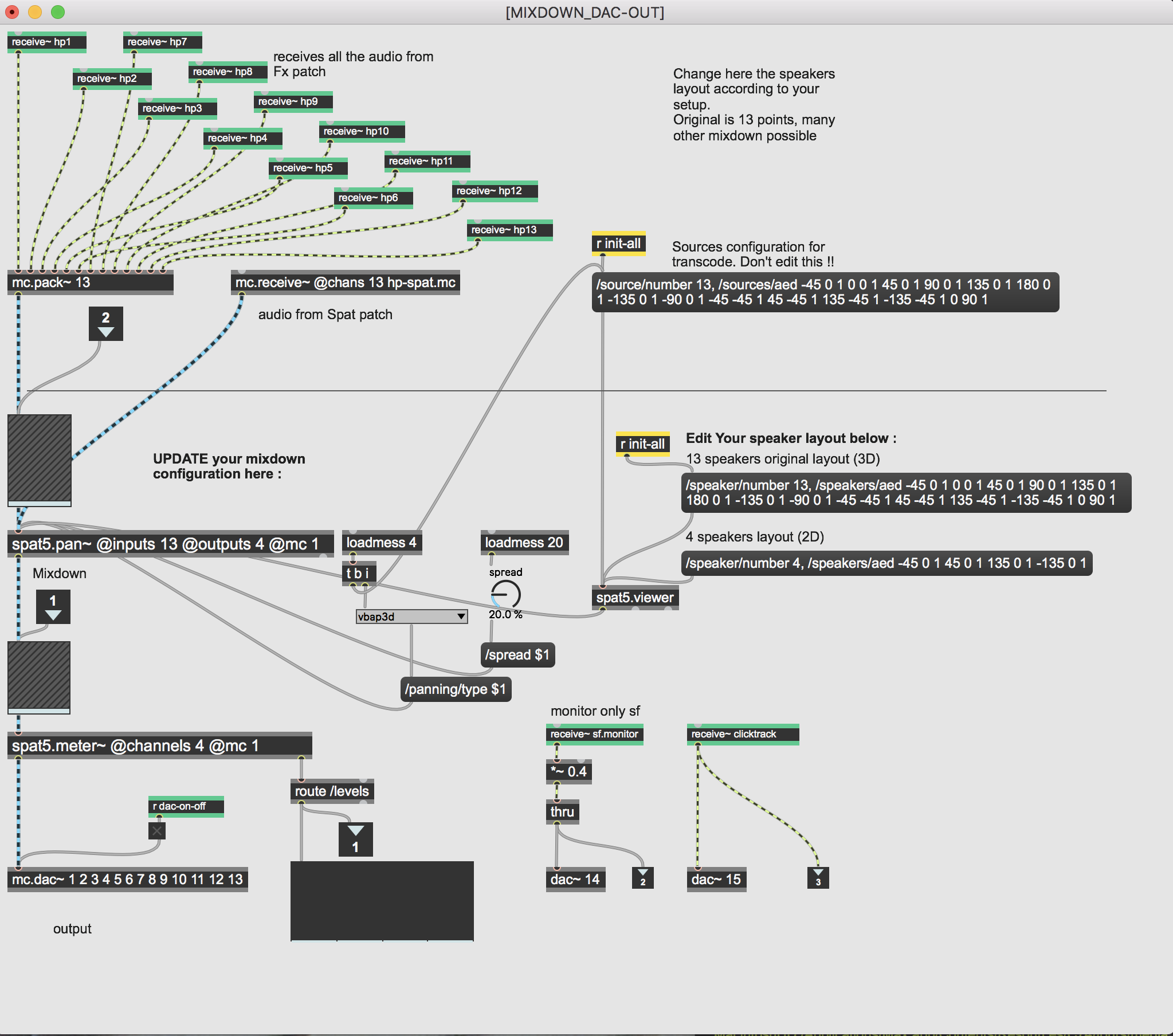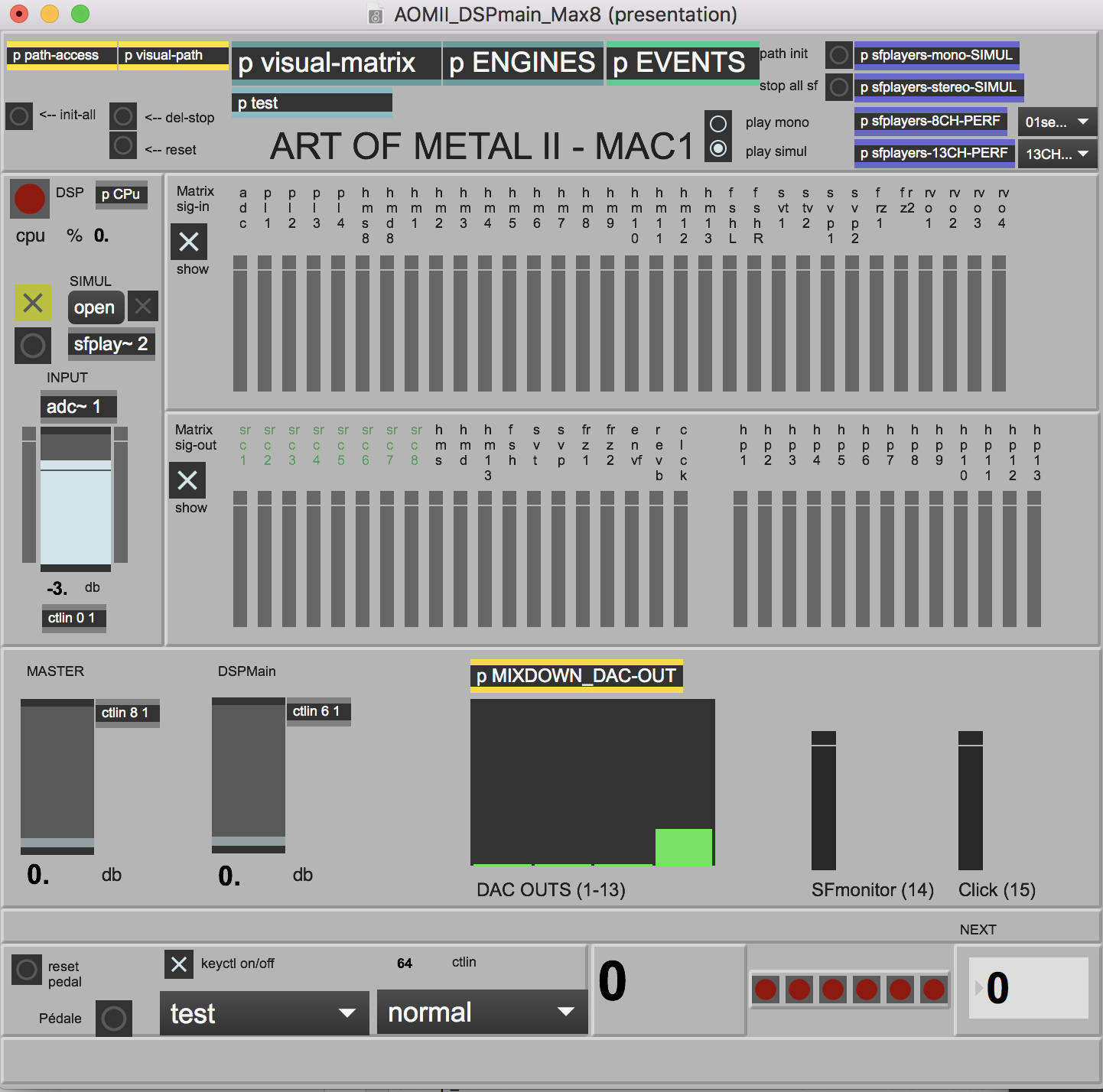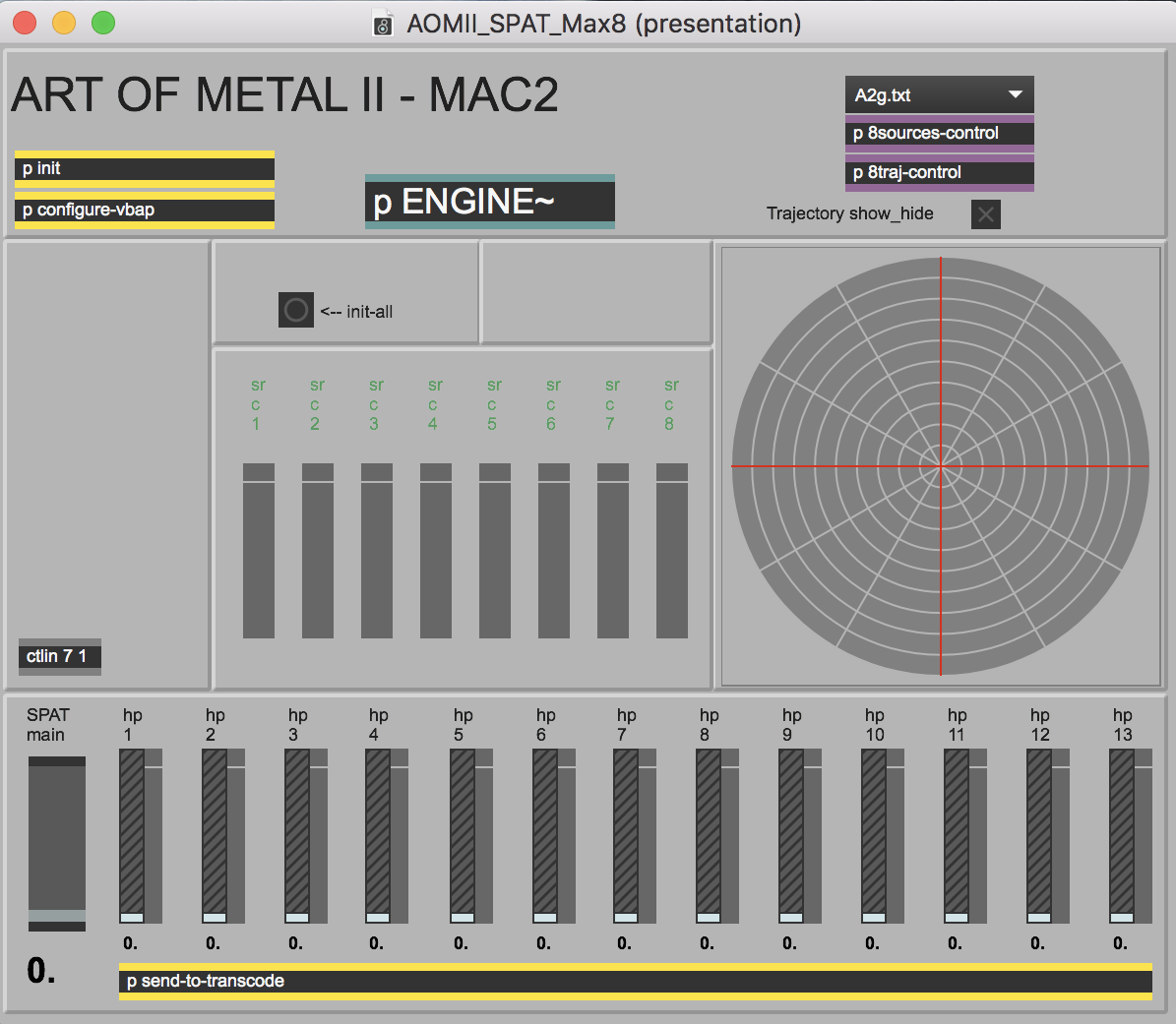Art of Metal II
Max8_64b_Port
Yann Robin
Outline
action
Updated at
Do you notice a mistake?
The setup and the execution of the electroacoustic part of this work requires a Computer Music Designer (Max expert).
Version Information
- Documentation date
- March 3, 2020
- Version
- Max8_64b_Port
- Status
- valid
- Validation date
- December 17, 2020
- Documentalist
- Augustin Muller (Augustin.Muller@ircam.fr)
- Realisation
- Charles Bascou (Computer Music Designer)
- Augustin Muller (Computer Music Designer)
- Length
- 11 min
- Upgrade motivation
- Portage Charles Bascou 2 projects in the same Max 8 app. 64 bits Spat5 No mxj scalable output format
- Comment
- updated version, not tested in concert.
Other Versions
AOM2 MoscouvalidSeptember 10, 2021
Vuittonin_progressJanuary 24, 2019
40ans EIC (no cut)documentedJanuary 12, 2018
40ans EICvalidApril 14, 2017
AOM2 Lille-2016documentedJanuary 26, 2016
venise 2013archivedOctober 24, 2013
Venise-2011archivedJanuary 24, 2013
strassburgarchivedOctober 5, 2010
transfert_mustica_ftparchivedApril 14, 2010
Detailed Staff
contrabass clarinet
Detailed staff comes from Brahms, send mail to ressources-contenus@ircam.fr for correction.
Channel Details
- Number of input channels
- 1
- Number of output channels
- 13
Electronic Equipment List
Audio Equipment
- 2 DPA 4021
- Condenser Microphones (DPA) - on both sides of the instrument
- 1 Microphone
- Microphone (generic) - "overhead" above the clarinet
Computer Music Equipment
- 2 Fireface 800
- Sound Board (RME) - 1 for the main computer , 1 for the spare computer
- 1 MIDI booster
- Booster (generic) - to send the MIDI pedal to the back of the room (and split)
- 1 Footswitch / Sustain Pedal
- Footswitch / Sustain Pedal (generic) - for the clarinetist to trigger the cues
- 2 MacBook Pro
- Apple Laptops (Apple) - 1 main, 1 spare (if main fails)
- 1 footswitch control
- MIDI Controllers (MIDI Solution) - to convert the pedal to MIDI
- 1 Max 8
- Max (Cycling74)
Downloads
Test files
A. Billard
comment
audio files for testing
10.33 Mo
Score
Y. Robin
comment
Ed. Jobert
450.15 Ko
AOM2_2020_Port
475.21 Mo
Setup
B. Lévy
comment
Audio & MIDI setup
366.26 Ko
Pedal use
B. Levy
comment
foot pedal shoud be in use mode
15.28 Ko
aom_dspmain
217.21 Ko
aom_spat
169.96 Ko
aom_13chspeakers
158.36 Ko
aom_mixdown
533.09 Ko
Instructions
IMPORTANT INFO
This version includes the performance AUDIO FILES with 8 CHANNELS ONLY & 13 channels only. The original version includes some simulation sound files (mono or stereo). If you need those, download a previous version of the piece!
Audio setup :
• 1 Live Audio input (mixdown of the clarinet mics) goes to main DSP patch.
• Up to 13 audio outputs for speakers (original version) + 1 sfiles monitor + 1 optionnal click track Output mixdown is possible in the main patch for configurations with less speakers.
MAIN DSP PATCH IO :
- 1 Mic Input
- 15 outputs + Sends
* 1-13 => speakers 1 to 13 /Scalable
* L-C-R SideR-SurR-SurC-SurL-SideL-DownL-DownR-DownSurR-DownSurL-Top / Scalable
* 14 => Sf Monitor (unused)
* 15 => optionnal click track
SPAT PATCH
- 8 receive Input from DSP patch:
- 13 outputs sends to Main DSP :
* 1-13 => speakers 1 to 13
* L-C-R SideR-SurR-SurC-SurL-SideL-DownL-DownR-DownSurR-DownSurL-Top
the original speaker layout still used for the trajectories & premix before pixdown is as follows :

Mic Setup
several microphones are needed to capture the sound of the clarinet.
For the top microphone, pavillion, we used an extra dynamic microphone (beyer M88) processed in a way to get a kick)like effect on the low C (Bb) slaps, using gate, resonnant lowpass (40Hz) and compressor. The sensation of these slaps must be physical, almost like a kick bass drum.
Loudspeaker setup
Up to 13 speakers :L-C-R SideR-SurR-SurC-SurL-SideL-DownL-DownR-DownSurR-DownSurL-Top
18 inches subs are required.
Midi setup
The clarinetist triggers the cues of the score/patch with a foot pedal sent in MIDI to the computer. When an analog footswitch or sustain pedal is used (as it was the case in this version) it needs to be converted to MIDI with a MIDI Solutions Footswitch Controller. If the console and computers are far away from the stage, a MIDI Booster is used to reinforce the MIDI transmission. It is used to duplicate the MIDI info for main and spare computers. You may control the levels of the Input, the Main DSP output, the Spatialization Output and the Master by a fader controller.
Software
You need one instance of Max 8. You may enable 'Enable Mixer in Parallel Processing'
This version is composed of two Max Projects:
AoMII_DSPMain_Max8.maxproj
AoMII_SPAT_Max8.maxproj
Except for the routing, no special Max setup is required for this piece. We use this standard setup :
- I/O Vector Size: 512
- Signal Vector Size: 256
- Sampling Rate: 48000Hz
- Scheduler in Overdrive: yes
- in Audio Interrupt: no
System calibration and tests
The input level should be set rather high for the effects to work properly.
Two soundfiles can be used as a simulation to quickly test the patch without the clarinetist. CLCB-sectA_05-diff.aifis a recording of the first 28 bars of the piece. CLCB-sectB-37_49-diff.aif is a recording of the bars 37 to 49.
You may need to adapt the mixdown for a particular setup different from the original 13 points layout. For this, have a look at the mixdown subpatch in the dsp_main. Adapt the spat5.pan~, spat5.meter~ to your number of outputs and configure correctly the viewer and the panning law. No other adjustment should be necessary for the spatialization.

Initialization routine
When launching the two projects, you can check for errors in the Max window.
Once you have loaded both projects:
- Start the audio with the red LED
Dac on/off. You can check that the CPU pourcentage near this LED is changing.
- Then
init-allwith the button of the Main.
- Check for errors , if you get an error from ambicontrol, try to re-do 'init-all'
- Pass one or two cues with your right arrow key (->)
- Then re
init-allwith the button of the Main
- Don't forget to check the input faders of both Max patches.
- For the pedal of the performer to actually trigger the cues, the mode menu should be set to
useinstead oftest

Patch presentation
• The DSP main patch interface:

This patch handles the sound fx,the soundfiles, the score & transport. The Input levels, Fx levels and master out are followed here (by mici ccs). It is the main audio inputoutput. It sends and receives audio wiith the spat patch.
• The SPAT (spatialization) main patch interface:

This handles all the trajectories. Be sure that they are correctly loaded (sources should visually move with concerned events)
The level of the spat is followed here (by midi CC 7). The audio is sent back to the main patch.
Performance notes
In general, Yann Robin likes when the sound coming from the computer is loud in the room! Adjust the volume consequently!
- The first sound of the electronics, triggered at the first note of the performer should be really impressive in the room, like a scream. This effect is mosly given by the Spat patches out
- From cue 11, the electronics is much quiter then grow again progressively. Keep this as a rather long crescendo in the electronics, don't push up the volume directly.
- At the end, the last section of slaps (pedal 44 to 45), the electronics have to be quieter and distant.
Updated at
Do you notice a mistake?